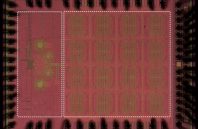Autonomous vehicles relying on light-based image sensors often struggle to see through blinding conditions, such as fog. But Massachusetts Institute of Technology (MIT; Cambridge, MA) researchers have developed a sub-terahertz-radiation receiving system that could help steer driverless cars when traditional lidar methods fail.
Sub-terahertz wavelengths, which are between microwave and infrared radiation on the electromagnetic spectrum, can be detected through fog and dust clouds with ease, whereas the infrared-based lidar imaging systems used in autonomous vehicles struggle. To detect objects, a sub-terahertz imaging system sends an initial signal through a transmitter; a receiver then measures the absorption and reflection of the rebounding sub-terahertz wavelengths. That sends a signal to a processor that recreates an image of the object.
But implementing sub-terahertz sensors into driverless cars is challenging. Sensitive, accurate object-recognition requires a strong output baseband signal from receiver to processor. Traditional systems, made of discrete components that produce such signals, are large and expensive. Smaller, on-chip sensor arrays exist, but they produce weak signals.

 (585) 768-2513
(585) 768-2513

